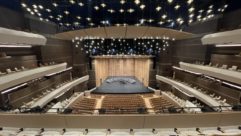Systems Contractors and the ADA
Jan 1, 2003 12:00 PM,
George Petersen
Since the Americans with Disabilities Act (ADA) became law in 1990, there has been no shortage of confusion regarding the definitions of exactly whom it does and does not apply to. Properties that may be exempt to the provisions of the ADA may include private clubs, historic buildings, religious affiliations, and even federal buildings. However, the latter are covered by the Rehabilitation Act of 1973 and under the Architectural Barriers Act. After a few years, ADA amendments were made to clarify numerous issues: ADA Title II applies to the operations of state and local governments (including public schools); Title III covers commercial facilities, certain private entities, and public accommodations.
Title III (and more specifically, Regulation 28 CFR, Part 36) deals with nondiscrimination in public accommodations and commercial facilities — that is (or should be) of major interest to systems contractors. The term commercial facilities is clear enough, but according to the ADA, public accommodations include places that affect commerce, such as hotels, restaurants, bars, motion-picture houses, theaters, concert halls, stadiums, auditoriums, convention centers, lecture halls, stores, shopping centers, funeral parlors, gas stations, health care providers, hospitals, public-transportation terminals, museums, libraries, galleries, parks, zoos, private schools, senior centers, gymnasiums, and bowling alleys. Many of those (or similar) facilities would certainly fall into a contractor’s list of prospective clients, along with the bread-and-butter local governments and public-school markets you’re all so familiar with.
Regulation 28 CFR, Part 36, Subpart C includes the specific ADA requirements of the facilities I described and, under Auxiliary Aids and Services (sec. 36.303), lists assistive listening devices, assistive listening systems, closed-captioning decoders, videotext displays, and other effective methods of making aurally delivered materials available to individuals with hearing impairments.
Equipped with a list of potential clients and a list of gear to sell, your next step is building your knowledge base so you can give solid advice and implement it into your job bids.
The entire text of the ADA is hundreds of pages long. It’s a lot of reading, but fortunately, the U.S. Department of Justice Web site offers all sorts of ADA-related information and technical assistance. Log on to www.usdoj.gov/crt/ada for resources, numerous short bulletins and technical papers written in lay language, as well as the entire text of the ADA in downloadable text or PDF format. The hefty 4.5 MB document is a long download if you have dial-up Web access. The PDF version of the ADA standards has the full formatted text and graphics, complete with links to figures and cross-referenced sections, making it easier for users to quickly read and understand. As an alternative, fill in the online form to request a free copy of the ADA Technical Assistance CD-ROM, containing ADA regulations, ADA design standards, and tech documents on one disc. Delivery takes six to eight weeks. You can order a copy by calling the main ADA information number — (800) 514-0301 — but after being on hold for a few days, you may find the online form is a lot faster. The ADA CD-ROM also provides an ideal field reference: using a laptop computer, a contractor can go over ADA provisions with clients during any phase of a project — consultation, sales, construction, or installation.
If the simple act of compliance with ADA regulations isn’t enough to get your clients excited, perhaps tax incentives will. Established under Section 44 of the Internal Revenue Code in 1990, a federal tax credit is available to help small businesses — defined as those having 30 or fewer employees or revenues up to $1,000,000 — offset the costs of ADA-related eligible access expenditures, including the purchase of adaptive equipment, such as assistive listening devices. The $5,000 maximum credit can be used only for adaptations to existing facilities that are required to comply with the ADA and cannot be used for the costs of new construction. IRS Form 8826 is used to claim the tax credit. For more information and downloadable forms, visit www.irs.gov.









